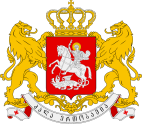Principality of Iberia
Principality of Iberia ქართლის საერისმთავრო kartlis saerismtavro | |||||||||||||
|---|---|---|---|---|---|---|---|---|---|---|---|---|---|
| c. 588–888 | |||||||||||||
|
Flag | |||||||||||||
| Status | Principality | ||||||||||||
| Capital |
| ||||||||||||
| Common languages | Iberia in 888–923 | Adarnase IV (last prince) | |||||||||||
| Historical era | Iberian kingship | 888 | |||||||||||
| |||||||||||||
| Part of a series on the |
| History of Georgia |
|---|
 |
Principality of Iberia or Principality of Kartli (
The time of the principate was climacteric in the history of Georgia; the principality saw the final formation of the Georgian Christian church, the first flourishing of a literary tradition in the native language, the rise of the Georgian Bagratid family, and the beginning of cultural and political unification of various feudal enclaves, which would be united to form the Kingdom of Georgia by the early 11th century.
History
When the king of a great unified Iberia,
Thus, the establishment of the principate marked the ascendancy of the dynastic aristocracy in Iberia and was a compromise solution amid the Byzantine-Sassanid rivalry for the control of the Caucasus. The presiding princes of Iberia, as the leading local political authority, were to be confirmed and sanctioned by the court of
Through offering their protection to the Iberian principate, the Byzantine emperors pushed to limit Sassanid and then Islamic influence in the Caucasus, but the princes of Iberia were not always consistent in their pro-Byzantine line, and, as a matter of political expediency, sometimes recognized the suzerainty of the rival regional powers.[3]
Guaram's successor, the second presiding prince
The extinction of the Guaramids and near-extinction of the Chosroids allowed their energetic cousins of the Bagratid family, in the person of
Presiding princes of Iberia
| Princes | Reign | Dynasty |
|---|---|---|
| 1. Guaram I | 588 – c. 590 | Guaramids |
| 2. Stephen I | 590–627 | Guaramids |
| 3. Adarnase I | 627–637/642 | Chosroids |
| 4. Stephen II | 637/642 – c. 650 | Chosroids |
| 5. Adarnase II | 650–684 | Chosroids |
| 6. Guaram II | 684 – c. 693 | Guaramids |
| 8. Guaram III | 693 – c. 748 | Guaramids |
| 9. Adarnase III | 748 – c. 760 | Nersianids |
| 10. Nerse | 760–772, 775–779/780 | Nersianids |
| 11. Stephen III | 779/780–786 | Guaramids |
| 12. Ashot I | 813–830 | Bagrationi |
| 13. Bagrat I | 842/843–876 | Bagrationi |
| 14. David I | 876–881 | Bagrationi |
| 15. Gurgen I | 881–888 | Bagrationi |
Gallery
Church architecture in the principality
-
Ateni Sioni Church, early 600s
-
Jvari monastery, 586-605
-
Tsromi church, 626–634
Notes
- ^ a b c d Suny, p. 25.
- ^ Toumanoff, p. 388.
- ^ Rapp, Stephen H., "Sumbat Davitis-dze and the Vocabulary of Political Authority in the Era of Georgian Unification", Journal of the American Oriental Society, 120.4 (October–December 2000), pp. 570–576.
- ^ Suny, p. 26.
- ^ Suny, p. 29.
- ^ Suny, p. 28.
- ^ Suny, pp. 29–30.
References
- ISBN 0-253-20915-3.
- Toumanoff, Cyril (1963), Studies in Christian Caucasian History. Georgetown University Press.





